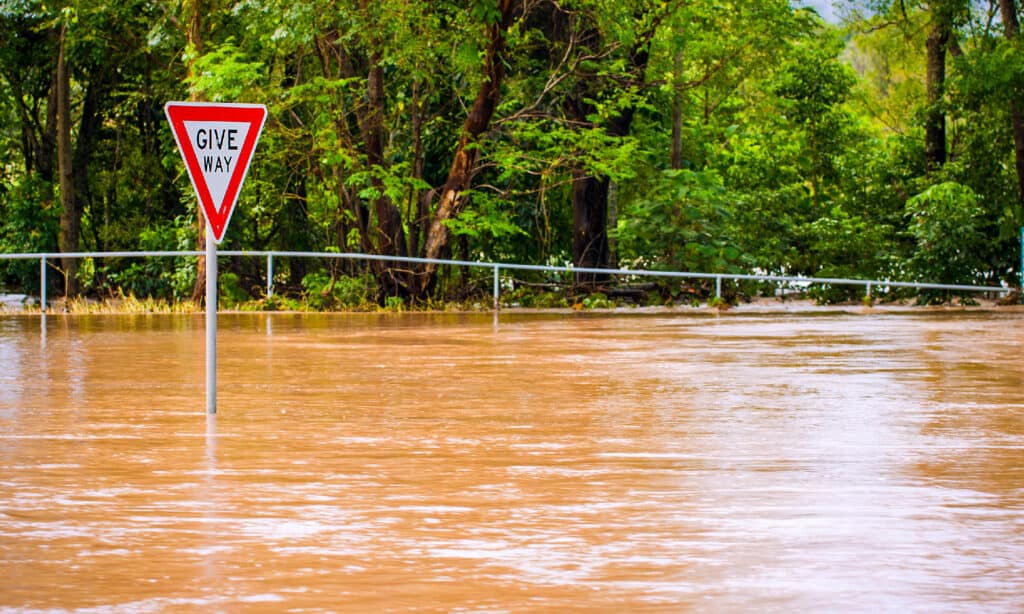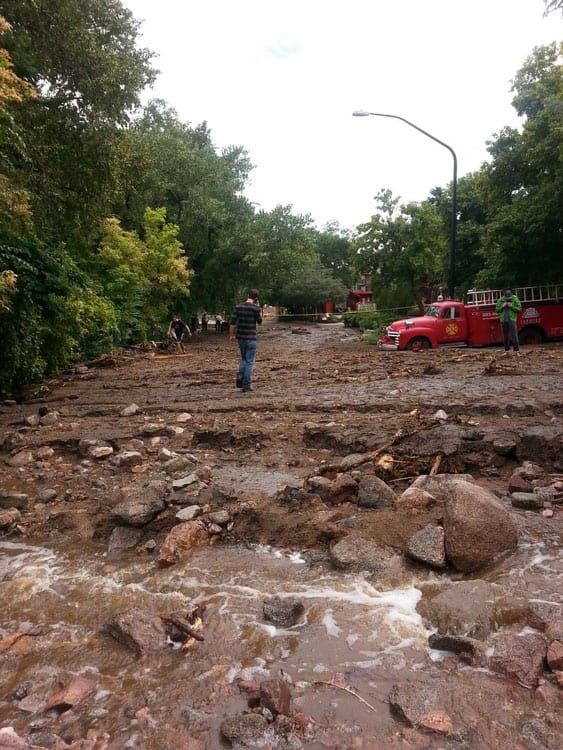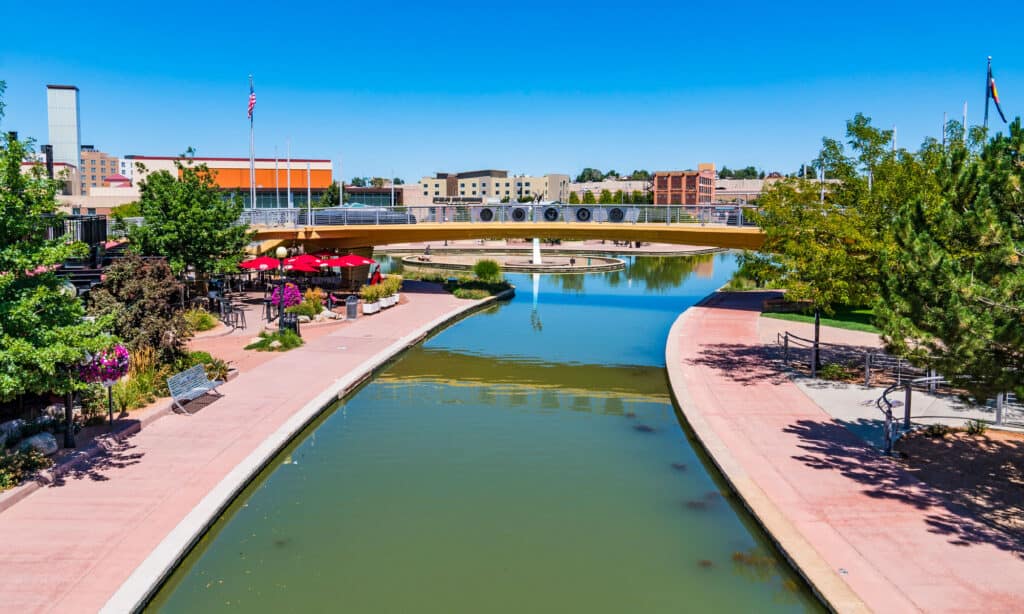Colorado is a state known for its unbridled nature including beautiful mountains, rivers, lakes, and more. Many people move to the state to be closer to nature. Avid hikers in the area enjoy summiting as many of the 30+ “14ers,” peaks that are around 14,000 feet high, as possible. However, with all of this natural beauty comes a greater risk of flash flooding. Flash floods can happen just about anywhere if the weather conditions are right, but mountainous terrain creates dangerous flash flood conditions when the elements are just right.
Exacerbating the risk of flash floods is the state’s tendency for wildfires. Areas that have burned recently are more prone to flash floods because the ground does not absorb water as well. Burned soil repels water almost as much as pavement in some cases. So, the water just runs off instead of going into the ground. Highlighted below are 3 terrifying flash floods that took place in Colorado.
1. Colorado’s Deadliest Flash Flood: July 31, 1976

144 people died in this flash flood incident.
©iStock.com/Jaykayl
On July 31, 1976, a strong thunderstorm near Estes Park, CO poured down a foot of rain in just six hours. This caused the Big Thompson River, located in Big Thompson Canyon to rise rapidly. The canyon itself is an important thoroughfare that contains a road connecting Estes Park to Loveland and the Fort Collins Metropolitan Area. The area is also popular with campers and tourists. This particular weekend was part of a 3-day celebration of the 100th anniversary of the state. So, people were out enjoying the beautiful surroundings as part of the celebration. The river rose so quickly that it overcame the road and people got trapped. More than 400 vehicles full of people trying to escape were swept off the road down into the canyon. Homes were washed away and a 275-ton boulder (over 600,000 pounds) was moved by the power of the raging waters. Children were swept out of their parent’s arms as they tried to escape the raging waters.
Overall 144 people died. One of those, Sgt. Willis Hugh Purdy, is credited with saving dozens and perhaps hundreds of lives. He went further into danger to warn those in the lower part of the canyon about the impending flood before getting caught on the road and swept away in the flood. Over 250 people were injured and 800 people were rescued from the canyon the following day.
Because of this deadly flood, all across Colorado, roads in canyons have signs that tell drivers to seek higher ground in a flash flood. Route 34, the road that runs through Big Thompson Canyon, was rebuilt on higher ground to withstand future floods. Experts credited the adjustments made after the 1976 flood for saving lives in a 2013 flood in the same area.
2. The Most Homes Damaged in a Flash Flood in Colorado: The September 2013 Floods

More than 19,000 homes were severely damaged by the floods.
©AlmanacManiac / CC BY-SA 3.0 – License
For a week in September 2013, heavy rain fell across a large area of Colorado known as the Front Range. This is a section of the Rocky Mountains that runs from Cheyenne, WY to Pueblo, CO. Between 10 and 20 inches of rain fell that week, depending on the area. Multiple rivers flooded, including the Big Thompson River from the 1976 flood, along with the Little Thompson River, Coal Creek, Lefthand Creek, and St. Vrain Creek. There was devastating flooding in 17 counties in the state. 20,000 homes were affected. Around 19,000 of them were damaged, and over 1,000 homes were fully destroyed.
With roads and bridges completely destroyed, some residents used ziplines to cross creeks and rivers after the flood had died down. Others had to hike into their homes to retrieve important items before roads were rebuilt.
To give an example of just how extreme this storm was, Boulder County received more than its average annual rainfall in a period of five days. However, only 8 people died as a result of the floods. Experts credit modern warning systems and education about what to do in a flash flood as a reason for the low number of deaths despite the extremely widespread flooding.
3. The Flood That Changed the Course of a River: 1921 Flood in Pueblo, Colorado

The course of the Arkansas river was changed to prevent future flooding.
©iStock.com/pabradyphoto
The Arkansas River once flowed straight through the downtown area of Pueblo, Colorado. However, a flood in June of 1921 changed that. On June 3rd, a combination of heavy rains and snowmelt caused the river to start to rise. Warnings went out, and the police blew a whistle that was typically used to warn people about fires, but it was too late. Around 8:30 pm, the river spilled over its banks and a wall of water overtook the densely populated business district. The flood swept two passenger trains off the tracks. Many were able to escape the trains, but 17 train passengers died. At that time, train cars were made of wood and floated easily in water. Carried by the raging water, they crashed into other buildings, creating more damage. Historians say there’s no way to know exactly how many people died in the floods. Some estimates are as low as 78. Others are as high as 1,500.
Very few buildings survived the flood, and rebuilding started immediately. City administrators and engineers worked together to move the course of the Arkansas River about 1/3 of a mile away, south of the downtown area. They created high levees around it to prevent another disaster like that from happening again.
Flash Flood Safety
Experts credit flash flood education and warnings as an important factor in reducing death tolls from these extreme weather events. So, how can you stay safe in a flash flood?
- Be aware of weather alerts: A flash flood warning means flooding is happening in your area. A flash flood watch means a flash flood could develop soon. If there is a flash flood warning, seek higher ground immediately. If there is a flash flood watch, stay vigilant.
- “Turn around, don’t drown.” This catchy saying may save your life. Don’t drive into flood waters. It only takes a small amount of water to disable your car, and flash flood waters rise quickly. Cars can get swept away in less than two feet of water. If you are already in your car and water is rising around you, get out of your car and seek higher ground, do not stay in or with your car.
- Do not attempt to cross swiftly moving floodwaters that are higher than your ankles. As few as six inches of water with a strong current can knock you down and sweep you downstream.
- If you are caught in a flash flood, do not try to outrun the flood. Seek higher ground immediately. This is true whether you are in an urban or wilderness environment.
- Follow any evacuation or shelter-in-place orders.
Up Next:
- Discover the Highest Point in Colorado
- What Is a Flash Flood? The Deadly Phenomenon Explained
- The 5 Largest Flash Floods in California
- 4 Terrifying Flash Floods In Utah
- 5 Terrifying Flash Floods In Arizona
- The 6 Biggest Floods Ever Recorded on Earth
The photo featured at the top of this post is © iStock.com/Jaykayl
Sources
- Wikipedia, Available here: https://en.wikipedia.org/wiki/2013_Colorado_floods
- CPR, Available here: https://www.cpr.org/2021/06/10/1921-pueblo-flood-recovery-photos/
- Coloradoan, Available here: https://www.coloradoan.com/story/news/2016/07/29/big-thompson-flood-killed-scores/87524858/
- American Red Cross, Available here: https://www.redcross.org/about-us/news-and-events/news/2018/flash-flooding---how-to-stay-safe.html
FAQs (Frequently Asked Questions)
What was Colorado's deadliest flash flood?
The deadliest flood in Colorado was the July 31, 1976 flood in Big Thompson Canyon.
How many people died in the 1976 Colorado flood?
144 people died in the 1976 Colorado flood.
What flood damaged the most homes in Colorado?
The floods in September 2013 damaged the most homes out of any flood in Colorado.
How many homes were damaged in the September 2013 Colorado floods?
More than 20,000 homes were damaged or destroyed in the September 2013 Colorado floods.
How many people died in the 1921 Pueblo, CO flood?
Historians say there’s no way to know exactly how many people died in the floods. Some estimates are as low as 78. Others are as high as 1,500.
How can I stay safe in a flash flood?
- Be aware of weather alerts: A flash flood warning means flooding is happening in your area. A flash flood watch means a flash flood could develop soon. If there is a flash flood warning, seek higher ground immediately. If there is a flash flood watch, stay vigilant.
- “Turn around, don’t drown.” This catchy saying may save your life. Don’t drive into flood waters. It only takes a small amount of water to disable your car, and flash flood waters rise quickly. Cars can get swept away in less than two feet of water. If you are already in your car and water is rising around you, get out of your car and seek higher ground, do not stay in or with your car.
- Do not attempt to cross swiftly moving floodwaters that are higher than your ankles. As few as six inches of water with a strong current can knock you down and sweep you downstream.
- If you are caught in a flash flood, do not try to outrun the flood. Seek higher ground immediately. This is true whether you are in an urban or wilderness environment.
- Follow any evacuation or shelter-in-place orders.
Thank you for reading! Have some feedback for us? Contact the AZ Animals editorial team.







